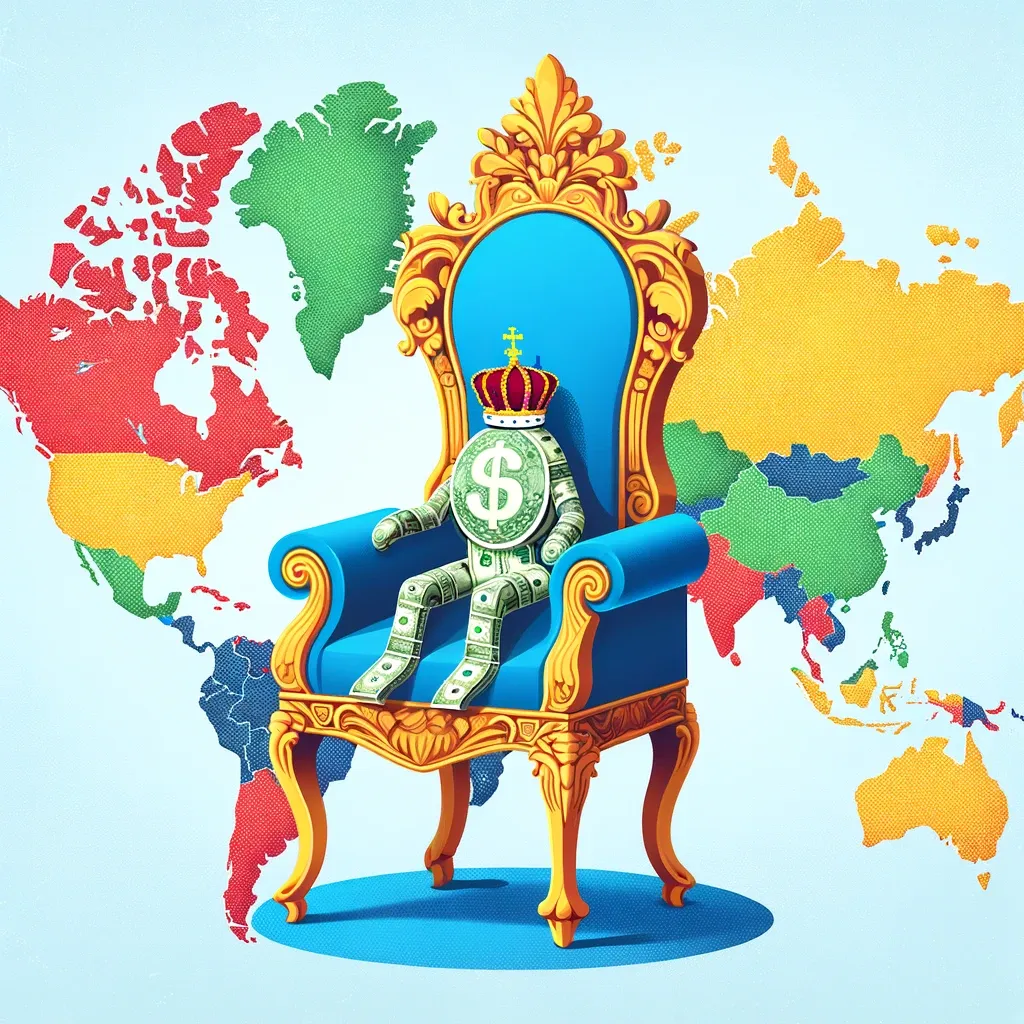Post-World War I
World War I really hit European economies hard. Imagine countries spending like there's no tomorrow, only it's on the war, not on fun stuff. This rapid spending left them with huge debts and their industries in rough shape. Their currencies, which were once the big players in global trade, took a major hit.
Before the war, the European currencies, like the British pound, were the stars of the show in global trade. But after the war, they lost a lot of their shine. They became a bit shaky and less valuable because the war had caused so much economic trouble.
Now, over in the U.S., the story was quite different. They managed to avoid the direct damage from the war. In fact, they ended up in a better spot because they were the ones supplying Europe with weapons and goods during the war. This was a big boost for the U.S. economy.
So, while Europe was picking up the pieces, the U.S. was moving up in the world, financially speaking. The U.S. dollar started to look pretty good in comparison to the European currencies – it was seen as more stable and trustworthy.
After the war, there was this global craving for something stable, especially for international trade and rebuilding economies. And that's where the U.S. dollar came into the picture. It was in a good place, seemed reliable, and countries began to lean on it for their international dealings. That was the starting point for the U.S. dollar to become a major player in the global currency game.
The Bretton Woods Agreement (1944)
In 1944, as World War II was drawing to a close, leaders from 44 countries gathered at a hotel in Bretton Woods, New Hampshire. Their big goal? To create a new financial order that would prevent future economic disasters like the Great Depression.
These leaders came up with the Bretton Woods Agreement. This was like setting the rules for a new game in global finance. The main idea was to have stable currencies that didn't wildly go up and down in value. Stability was the name of the game.
A key part of the agreement was that other countries would tie the value of their currencies to the U.S. dollar. Why the dollar? Well, the U.S. had the biggest gold reserves at the time, and the dollar was the only currency that could be exchanged for gold. This made the dollar kind of like a gold standard.
This move put the U.S. dollar at the center of world finance. It became the go-to currency for international trade and financial dealings. Basically, if the global economy was a solar system, the U.S. dollar became the sun.
The Bretton Woods Agreement had a long-lasting impact. It laid the groundwork for major international financial institutions like the International Monetary Fund (IMF) and the World Bank. These institutions played (and continue to play) a big role in managing global financial stability.
Post-Bretton Woods Era - End of the Gold Standard: Nixon Shock (1971)
A major turning point came in 1971, often referred to as the 'Nixon Shock'. President Richard Nixon announced that the U.S. dollar would no longer be convertible to gold. This was a big deal because it effectively ended the Bretton Woods system.
This move shifted the global financial system from a gold standard to what is known as a fiat currency system. Fiat money is currency that a government declares to be legal tender, but it is not backed by a physical commodity like gold.
After the Nixon Shock, currencies, including the dollar, were valued based on supply and demand in the global markets, not gold.
The U.S. dollar, already well-established due to the Bretton Woods system, found even more strength in this new era. It continued to be the primary currency for international trade and reserves, despite not being backed by gold.
The U.S. economy's size and strength played a major role in the dollar's dominance. As the largest economy in the world, the U.S. had a significant influence on global trade and finance.
U.S. political stability and its influence in global affairs also contributed to the confidence in the dollar. Countries and businesses around the world continued to see the dollar as a safe and stable asset.
Global Trade and Petrodollars
A key factor in the dollar's dominance was its use in the global oil trade. In the 1970s, OPEC countries agreed to price and sell their oil exclusively in U.S. dollars, a system that became known as 'petrodollars'.
This agreement further entrenched the dollar's role in global trade, as countries needed dollars to purchase oil, the world's most traded commodity.
The U.S. financial markets, being the largest and most liquid, attracted investors from all over the world. This further increased the demand for the dollar.
International financial institutions, many of which were influenced by the U.S., also played a role in promoting the use of the dollar.
Technological and Financial Influence
The rapid advancement of technology has dramatically transformed the financial landscape. Innovations like digital banking, online transactions, and sophisticated financial tools have made the handling of money, particularly in U.S. dollars, much more accessible and efficient globally.
The U.S. dollar plays a pivotal role in international payment systems. Most international transactions, whether in trade, finance, or investments, involve the dollar at some stage. This is largely due to the trust and efficiency associated with the dollar, supported by advanced financial infrastructure and technology.
SWIFT (Society for Worldwide Interbank Financial Telecommunication), the global standard for financial messaging, predominantly handles transactions in U.S. dollars, further embedding its use in global finance. Many digital transactions and crypto trades are still pegged to the dollar, indicating its continued relevance in this new financial era.
International financial institutions like the International Monetary Fund (IMF) and the World Bank, which were outcomes of the Bretton Woods system, continue to use the U.S. dollar as their primary currency for international loans and grants. These institutions' reliance on the dollar for global financial operations further cements its status as the world’s leading currency.
The Federal Reserve, the central bank of the U.S., plays a crucial role in global finance through its monetary policies. Decisions made by the Federal Reserve regarding interest rates and money supply have far-reaching effects, influencing global markets and the valuation of the dollar. As a result, even non-U.S. businesses and governments must pay close attention to U.S. monetary policy, as it can significantly impact their economies and financial decisions.
Challenges and Future Outlook
The Euro, introduced in 1999, has emerged as a significant competitor to the U.S. dollar, especially within Europe. It represents the combined economic strength of the Eurozone countries, making it a viable alternative for international trade and reserve currency.
The Chinese Yuan is also gaining prominence, particularly with China's growing economic power. As China continues to expand its global trade relationships, the Yuan could challenge the dollar's dominance, especially in Asia and Africa.
Cryptocurrencies and digital assets are increasingly becoming part of the mainstream financial system. They offer an alternative to traditional banking systems and could disrupt the dominance of conventional currencies like the U.S. dollar.
Changing geopolitical landscapes, including trade wars, regional alliances, and economic policies, can influence the dominance of the U.S. dollar. Shifts in global power balances and economic alliances may lead to a more multipolar currency world.
The U.S.'s own domestic policies and international relations can significantly impact the dollar's global status. Issues like national debt, trade deficits, and political stability are key factors.
Summary
Post-World War I
- European economies were heavily impacted by war expenses, leading to debt and weakened industries.
- European currencies lost value and reliability post-war.
- The U.S. emerged economically stronger, having supplied Europe during the war.
- The U.S. dollar gained trust and stability, becoming more prominent in global trade.
The Bretton Woods Agreement (1944)
- Aimed to create a stable global financial order post-World War II.
- Established the U.S. dollar as the central currency, pegged to gold.
- Other countries’ currencies were tied to the dollar.
- Led to the formation of key financial institutions like the IMF and the World Bank which also favoured US dollar.
Post-Bretton Woods Era - Nixon Shock (1971)
- Ended the gold standard, moving to a fiat currency system.
- The U.S. dollar continued to be a key currency for international trade and reserves.
- The U.S. economy's strength and U.S. political stability reinforced the dollar's dominance.
Global Trade and Petrodollars
- The dollar became crucial in the global oil trade (petrodollars).
- U.S. financial markets and international financial institutions favored the dollar.
Technological and Financial Influence
- Technological advancements facilitated global dollar transactions.
- The U.S. dollar is pivotal in international payment systems and SWIFT transactions.
- The IMF and World Bank continue to use the dollar for international operations.
- U.S. Federal Reserve policies significantly influence the global value of the dollar.
Challenges and Future Outlook
- The Euro and Chinese Yuan are emerging as competitors to the dollar.
- Cryptocurrencies and digital assets present new challenges to traditional currencies.
- Global Trade war between US and China can split other countries to favour one over the other.
- Geopolitical changes and U.S. domestic policies could affect the dollar's global status.






